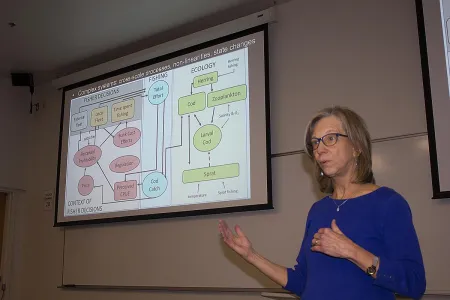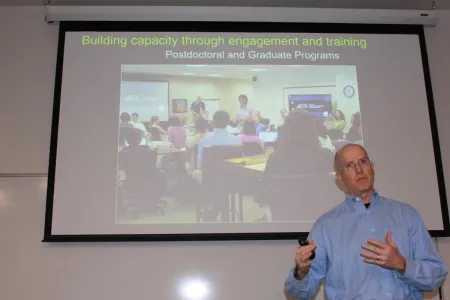For the past eight years, National Socio-Environmental Synthesis Center (SESYNC) of the University of Maryland (UMD) has been bridging the gap between the natural and social sciences to find solutions to pressing socio-environmental (S-E) problems. But for those new to UMD, there may be some confusion about what SESYNC does and how it does it.
So, to better illuminate SESYNC and the people and practices that make it unique, SESYNC’s Director Margaret Palmer and Director of Education and Outreach Dave Hawthorne recently gave students and faculty on the UMD campus an overview of the Center—explaining its origin, mission, research focus, and programs. Their talk was part of a weekly seminar series hosted by UMD’s Department of Entomology. Dr. Palmer, a Distinguished University Professor, and Dr. Hawthorne, an Associate Professor, are both faculty members of the Department.
Palmer opened the seminar by sharing how the need for a center that focused on synthesizing environmental and social research stemmed from the recognition that “all environmental problems are social by nature.”
The Center had initially been proposed to the National Science Foundation (NSF) as an experiment, Palmer explained, based on hypotheses about how to overcome the barriers and challenges associated with overcoming socio-environmental problems. She said NSF ultimately chose to fund SESYNC largely because they recognized “It’s really not easy to do this research that bridges these disciplines and more.”
Though other synthesis centers exist, Palmer explained that SESYNC has certain characteristics that make it unique. “We were tasked with saying we want to build new communities and new capacities to do this kind of research. And so that’s why some of the things we do are also a little different,” Palmer told attendees.
Another special characteristic is the Center’s emphasis on connecting researchers who haven’t worked together before to generate novel approaches and ideas. Palmer explained, “We require all teams be interdisciplinary and that at least 50% of the members of every team have not worked together previously. The reason for that is we’re trying to build new teams and new communities of researchers.”
“When we talk about building capacity in the ability to do S-E research,” explained Hawthorne, “what we really mean is taking people who are really smart and really well trained in a particular discipline and helping them to develop the skills to be able to work with people from other disciplines [and] to be able to work with diverse kinds of data that they’re not used to working with in a team setting to be able to address these sort of complicated systems-oriented problems.”
She added, “There’s also a lot of research that shows diversity of opinions and expertise—whether it’s tasks or theoretical perspectives—leads to more innovative research and more impact.”
Another important factor are the people who work at the Center. Palmer said that all of the staffs’ roles are designed to help teams—from the Center’s facilitators, to its resident journalist, to its computational team, to its director of research, and more. For example, SESYNC’s data science team plays a critical role in helping teams incorporate qualitative data from the social sciences with quantitative data from the natural sciences during their collaborations.
Something else that makes SESYNC unique is its focus on helping scientists shift their thinking from identifying environmental problems to solving environmental problems—to produce fundamental, actionable research.
“If you want to make your science actionable, and some of the decision makers are policy people, how do you figure out where the doors are so that you can go in and begin that process of making the relationships to be able to do those sorts of things?” Hawthorne asked the attendees. He explained how SESYNC offers resources like workshops and professional development opportunities to help researchers grow those skills.
Together, these unique practices allow SESYNC to support S-E research through several ways, including its Pursuits, which are team-based projects; Workshops; Short Courses; and more.
“It’s all about capacity development—taking people who are smart, motivated, prepared, ready to go, and helping them get to that next level, helping them get through that barrier that they’re currently facing so that they can continue to make contributions,” Hawthorne said. During the seminar, he spoke about SESYNC's distinctive education programs designed to build capacity among researchers and help them excel in interdisciplinary team science for application outside the Center. These programs include SESYNC’s Postdoctoral Fellowship Program, weekly seminar series, Immersion Program workshops, and more.
Due to the strong outcomes of the Center, Palmer said she and other leadership often receive questions asking how SESYNC does what it does, and if there are any outlines or steps that they can provide to help others conduct similar synthesis research. But Palmer explained, “It’s really not that easy. It’s the combination of all the things we do, in addition to what we consider the culture of the center. That is, it’s strongly supportive of helping teams in any way we can and also nurturing the community.”
For more information about this seminar, see UMD’s Department of Entomology’s Seminar Blog.

